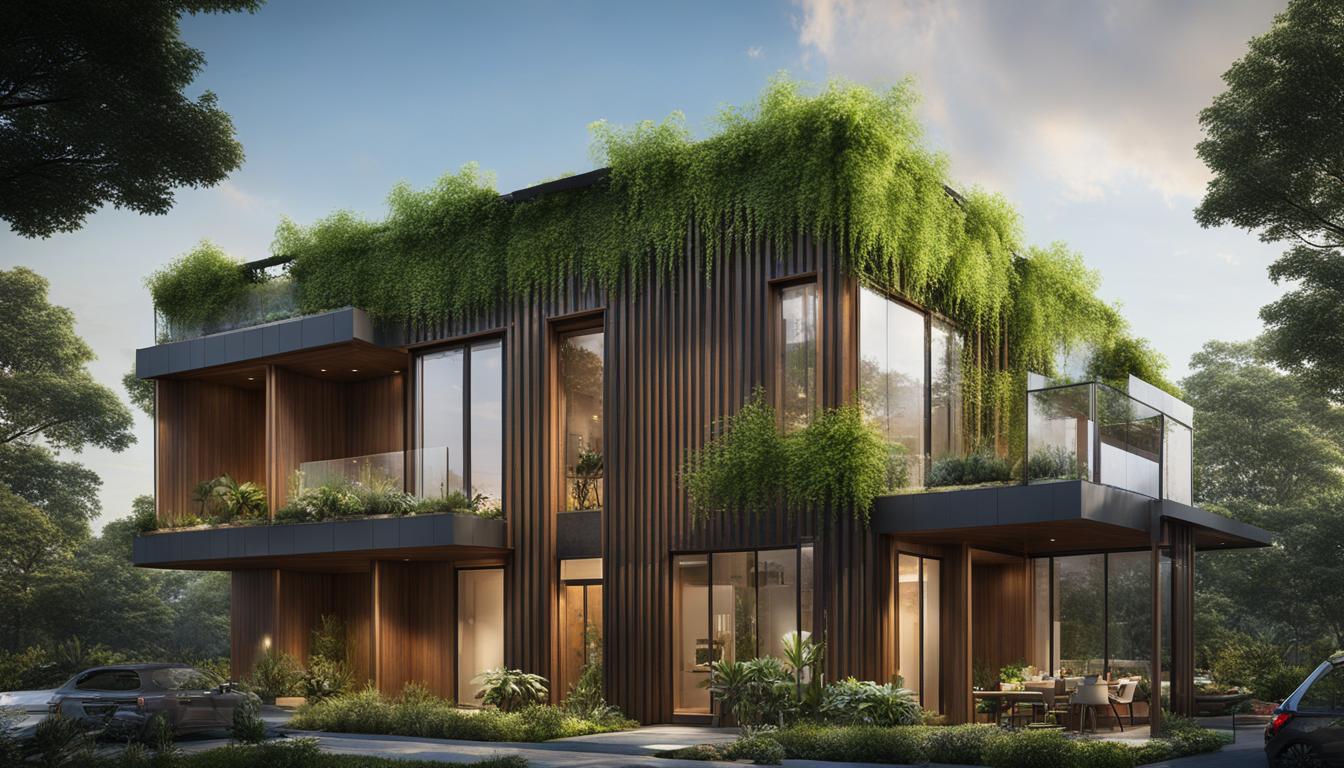Smart home technologies are revolutionizing the way we think about sustainability in the field of green building and architecture. These innovative solutions offer homeowners the opportunity to create more efficient, eco-friendly, and energy-conscious homes. With the growing demand for sustainable living, smart home features are becoming increasingly popular. According to research, the smart home market is projected to experience significant growth in the coming years, driven by consumer interest in convenience, energy management, and environmental consciousness.
Key Takeaways:
- Smart home technologies are transforming the concept of sustainability in green building and architecture.
- These innovative solutions enable homeowners to create efficient, eco-friendly homes.
- The demand for sustainable living is driving the popularity of smart home features.
- The smart home market is projected to experience significant growth in the coming years.
- Convenience, energy management, and environmental consciousness are key drivers of smart home adoption.
The Future of Smart Homes
The future of smart home technology is centered around the concept of connectivity and control. Traditionally, smart homes focused on home security, but now they are expanding to include energy management and efficiency. The rise of devices like smart thermostats has allowed homeowners to have more insight and control over their energy usage, resulting in lower energy costs and reduced carbon footprints.
Six types of future smart homes have been identified:
- The Sentient Home
- The Cooperative Home
- The New Lifestyle Home
- The Home as a Business
- The Low-Impact Home
- The Marketplace Home
The evolution of smart home technology presents homeowners with a range of options for designing their ideal living spaces. Local smart home control focuses on automation within individual devices or systems, allowing users to customize and operate them independently. On the other hand, centralized smart home control involves a centralized hub that manages and coordinates all connected devices. However, there is a third option emerging – a hybrid approach that combines local and centralized control for a more flexible and efficient smart home experience.
By embracing the future of smart homes, homeowners can enjoy enhanced convenience, energy efficiency, and lifestyle customization. Whether it’s managing energy usage, securing the premises, or optimizing day-to-day tasks, smart home technology offers endless possibilities for creating a connected and sustainable living environment.
Smart Home Technologies for Energy Efficiency
Smart home technologies are revolutionizing the way we manage energy consumption in our homes. By incorporating devices such as smart thermostats, smart lighting systems, smart shades, smart irrigation systems, and smart energy meters, homeowners can significantly improve energy efficiency and reduce their environmental impact.
Smart thermostats are key to optimizing heating and cooling in the home. These devices allow homeowners to remotely control the temperature settings and create personalized schedules based on their preferences and occupancy patterns. By utilizing smart thermostats, energy waste can be minimized, leading to lower utility bills and a greener home.
Another essential component of smart home energy efficiency is smart lighting systems. With these systems, homeowners can adjust lighting levels, set timers, and even automate lights to turn off when rooms are unoccupied. This not only saves energy but also enhances convenience and creates a more comfortable living environment.
Smart shades offer an innovative solution for harnessing natural light and heat gain. These shades can be remotely controlled and programmed to adjust based on the position of the sun and interior temperature. By optimizing natural lighting and reducing the need for artificial lighting and cooling, homeowners can further enhance energy efficiency.
In terms of outdoor energy consumption, smart irrigation systems are invaluable. These systems use real-time weather data to determine the optimal amount of water needed for the yard. By avoiding water waste and optimizing irrigation schedules, smart irrigation systems conserve water resources and promote sustainable landscaping practices.
Lastly, smart energy meters provide valuable insights into energy consumption patterns and help homeowners identify the most energy-hogging appliances. By monitoring energy usage in real-time, homeowners can make informed decisions about their energy consumption habits and take steps towards reducing their carbon footprint.
Overall, smart home technologies have the potential to significantly improve energy efficiency in our homes. By utilizing devices such as smart thermostats, smart lighting systems, smart shades, smart irrigation systems, and smart energy meters, homeowners can create a more sustainable and eco-friendly living environment.
Energy Efficiency and Smart Appliances
Traditional home appliances are known for their energy-intensive operations. However, smart appliances are designed to be energy-efficient. Through features like adaptive settings, load sensing, and intelligent algorithms, these appliances optimize resource usage and reduce energy consumption.
One example of energy-efficient smart appliances is the smart refrigerator. By utilizing adaptive settings and load sensing technology, smart refrigerators adjust their cooling settings based on the contents inside. This not only ensures optimal temperature control but also results in significant energy savings. With these intelligent features, homeowners can reduce their carbon footprint while keeping their food fresh and prolonging the lifespan of perishable items.
Another energy-efficient smart appliance is the smart washing machine. These appliances utilize advanced algorithms to analyze the size of the load and adjust water usage accordingly. By only using the necessary amount of water and detergent, smart washing machines minimize water waste and energy consumption. The result is cleaner clothes and a greener laundry routine.
Smart dishwashers are also designed with energy efficiency in mind. Equipped with load sensing technology, these appliances determine the optimal amount of water and energy required for each cycle based on the number of dishes and their dirtiness. By avoiding excessive water and energy usage, smart dishwashers provide spotless dishes while promoting sustainable practices.
Lastly, smart appliances like refrigerators, washing machines, and dishwashers often come with energy usage monitoring features. This allows homeowners to track their energy consumption in real-time and identify areas where energy-saving adjustments can be made. By providing insights into energy usage patterns, smart appliances empower homeowners to make informed decisions and further improve their energy efficiency efforts.

Conclusion
Smart home technology is transforming the way we live, offering endless opportunities to create a sustainable lifestyle. By integrating eco-friendly smart devices into our homes, we have the power to make a significant impact on the environment while embracing energy-conscious living.
From smart thermostats and lighting systems to smart plugs and energy monitoring devices, there are abundant options available for creating a greener home. These intelligent devices allow us to optimize energy usage, reduce waste, and minimize our carbon footprint, paving the way for a more eco-friendly world.
Embracing smart home technology not only contributes to a sustainable future but also enhances our comfort, convenience, and cost savings. By making simple yet powerful changes, like controlling our energy usage and automating our home systems, we can enjoy the benefits of a greener lifestyle while enjoying the latest advancements in technology.
With a commitment to sustainable living, smart home technology empowers homeowners to build a more eco-friendly world, one intelligent device at a time. By adopting these technologies, we can make a positive impact on the environment, reduce our ecological footprint, and create a better future for generations to come.
FAQ
What is green building and architecture?
Green building and architecture refer to the design and construction practices that focus on creating environmentally friendly and sustainable buildings. These practices aim to minimize the negative impact on the environment throughout the building’s lifecycle.
What is sustainable construction?
Sustainable construction involves using materials, techniques, and processes that are environmentally friendly and have minimal impact on natural resources. It aims to create buildings that are energy-efficient, resource-efficient, and have a reduced carbon footprint.
What is eco-friendly design?
Eco-friendly design focuses on creating products, systems, and environments that are beneficial to both humans and the environment. It often involves the use of renewable materials, energy-efficient technologies, and sustainable practices to reduce negative environmental impacts.
What is LEED certification?
LEED (Leadership in Energy and Environmental Design) certification is a globally recognized system for rating the sustainability and energy performance of buildings. It provides a framework for designing, constructing, operating, and maintaining green buildings.
What are green materials?
Green materials, also known as sustainable materials, are those that have minimal impact on the environment during their production, use, and disposal. They are typically made from renewable resources or recycled materials, and they often have low levels of toxicity.
What are sustainable practices in building construction?
Sustainable practices in building construction refer to the use of environmentally friendly and resource-efficient processes throughout the entire construction process. This includes using sustainable materials, minimizing waste, optimizing energy and water usage, and promoting indoor environmental quality.
What are green building techniques?
Green building techniques are methods used in construction to minimize the negative impact on the environment and maximize energy efficiency. These techniques may include passive design strategies, installing energy-efficient systems, using renewable materials, and implementing sustainable construction practices.
What is the role of environmental consciousness in architecture?
Environmental consciousness in architecture involves designing buildings that consider the environmental impact and strive to minimize it. Architects take into account factors such as energy efficiency, sustainable materials, waste reduction, and the use of renewable resources to create buildings that harmonize with the environment.
Source Links
- https://www.nar.realtor/magazine/real-estate-news/technology/smart-home-tech-that-enhances-home-efficiency
- https://connectedworld.com/smart-homes-lead-the-way-for-sustainability/?amp=1
- https://www.hdlautomation.com/Articles_100000160479646.html
- Regulatory and Compliance: Pioneering the Future of Saudi Arabia’s Dedicated Cargo Airline - December 21, 2024
- Financial Strategies: Fueling the Growth of Saudi Arabia’s Dedicated Cargo Airline - December 20, 2024
- Operational Excellence: Ensuring Competitive Edge for Saudi Arabia’s Dedicated Cargo Airline - December 19, 2024






